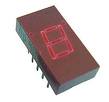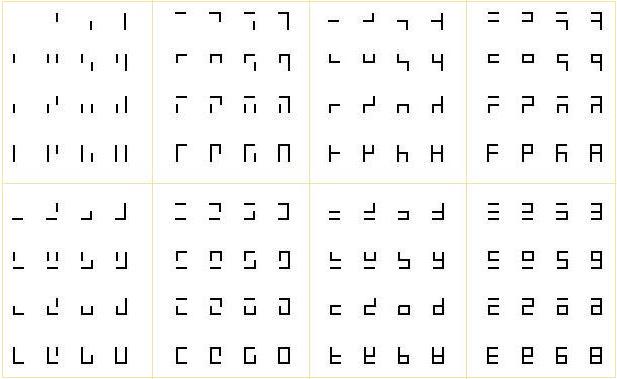The number seven has connotations of mystery and magic. Here it is the basis of a writing system, by virtue of the seven parts of a device famous for displaying information. Could the two aspects—magic and letterforms—combine to bring us... divine messages?
Notable Features
- a way to encode/decode chaotic electronic signals.
- uses a generic phonology based on binary subdivision.
- may be used for an alphabet.
Background
The 7-segment numeric LED is a common electronic component, found in clocks, calculators and other measuring devices. This component is usually set up to display numeric information, and limited to the ten numerals we all recognize:
But the full number of combinations of illuminated segments is 128, or two to the power of seven (including the fully blank state). So if all the possible shapes represented a font table, there is much more available than just numerals:
It would be a challenge to design a writing system that could utilize this set of glyphs in a meaningful way. Why might it even be considered?
Chaos & divination
It happened that a solar-powered 10-digit desk calculator was stored in a drawer each night, and brought out into the office light occasionally, as required. But before it was used, before the CLEAR button was pressed, it was always seen to hold a somewhat random sequence of non-numeric glyphs. This was jokingly referred to as “alien messages”. Probably a weak, itinerant flow of electrons had triggered various segments of the LED; not having a full or constant current from the light cells put the device “on the edge”, so to speak, into a chaotic state.
Now at the borderlands of possibility, which is the chaotic state, very subtle influences may be at work. As subtle as those which move the dial of the ouijah board, perhaps?
OK, so if there were messages, how would one translate them? Assuming the communicant accepted the limitations of a 7-bit code, but was unable to make shapes matching any known alphabet, it would be expected that a more general system of phonetics or orthography would be refered to.
General encoding
It is required that a 7-fold binary subdivision of our phonological system be made, in order to bring it in line with the way a set of seven lights combine their on/off states. It is not too difficult to find a way to deconstruct English phonetics (for example) in a way that fills the 128 places of this revised system.
What is important here, for the sake of meaningful interpretation, is the inclusion of wildcards. Without the last two segments (top-right and middle), there are but 32 places – adequate for a simplified phonetic alphabet. The two wildcards introduce alternatives which may allow for a broader interpretation, helping us make the most of what may well be completely random signals. A similar rationale allows the “decoding” of obscure Hebrew texts—which show neither vowels nor word-breaks—into seemingly accurate prophecies.
As for the actual assignment of concept to segment, this was a mainly aesthetic choice, where the fuller, more solid glyphs should stand for stronger sounds, and the lighter, emptier glyphs should stand for the most subtle sounds. A missing middle bar suggests lack of substance and therefore an abstract linguistic concept.
The direction of printing is assumed to be right-to-left, just as number entry happens on a calculator. This is the direction of Arabic, Syriac, Hebrew, etc.
Here is the result of applying the 5-fold subdivision (for the moment ignoring variables) to a mainly English phonology. Each glyph holds the initial sound of the word given; the word with * is French.
Now if we come across one of these glyphs with its top-right or middle stroke missing, we may juggle the sense: for example, a bilabial /m/ glyph may become a bilabial /p/ sound, or hold some kind of grammatical function. Thus we may engage our intuition somewhat, to divine the message.
Example
Here, the uncertain articulations are in red, the morphosyntactic possibilities shown as a diamond. At a first reading of this 10-digit display over three nights, we might get:
All human peeing
share(?) [verb ending?] bomb free [conjunction?]
icky indignant(?)
This is a clear message confirming the Declaration of Human Rights:
All human beings are born free & equal in dignity ...







